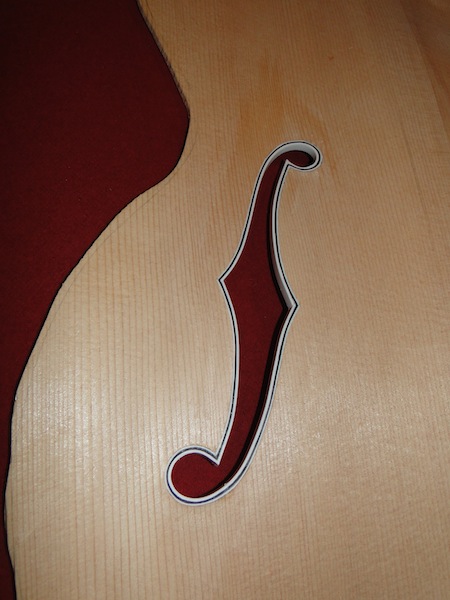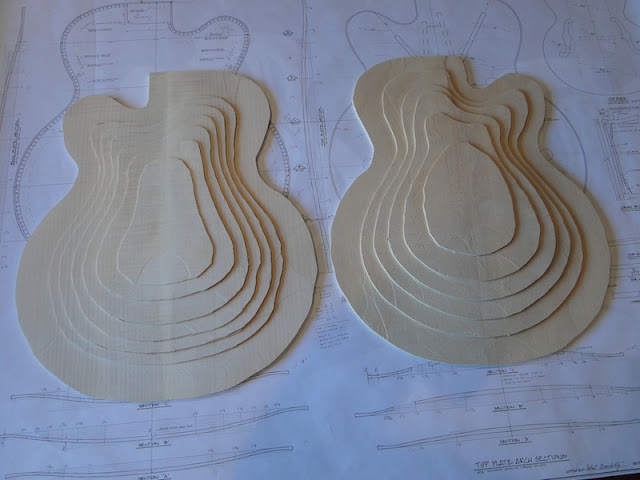Most of us start out building wooden projects that are made up of pieces of wood that are joined to one another at right angles and end up square and box-like. The top and the back of the archtop present a special challenge because they are anything but flat and two dimentional. The problem is how can a draftsman convey the shape to the builder? Here is where we can take a page from the naval draftsmen to solve this problem. Ships and boats are rarely square and box-like so naval draftsmen came up with a standard way of drawing up plans so the dockyard can build the vessel the way the designer envisioned it. The drafts look like this.

The three views are called (top to bottom) Body Plan (aka Hull Sections), Sheer Plan (side view) and Waterline Plan. The draftsmen for the Benedetto plans included some Body Plan views and one mid-line Sheer Plan view but no Waterline views. These are the ones that we really need so that we can know what the contour of the top and bottom should be! Leaving these out is a major flaw in these plans.
There is a way that we can make our own waterline views of the guitar and "loft" the plans for ourselves as a naval architect would do. Start by choosing a standard increment and draw a series of parallel lines starting at the base line and working your way up to the top of each Body Plan drawing. Next look for where the upper surface of the plan just crosses the scribed lines and draw a line at right angles from the baseline to this point. Next measure the distance from the center-line to this point and make a table of these values. In my case I chose 1/8 inch as the increment and made the measurements to the closest 1/16th inch. It should look something like this.

Now take an appropriately sized sheet of heavy card stock and trace the outline of the top onto it (in my case I used my body mold so that it is exactly what the shape of my guitar will be since the mold may vary slightly from the plans). Draw a center line as well as the index lines A-E from the plans. Now measure out from the center line and make small tics on the lines A-E from the table of measurements that you made previously. You can also take measurements from the center-line profiles (drawn to the left of the top and back plate drawings) but on my plans, only the top piece profile was accurately drawn (the back piece profile marks did not line up in such a way to make fair lines as described below).
Now you have to use your creative eye and connect the dots in such a way that the line lay "fair" to you. What does this mean? Take a look at the ship plans above and notice that all of the lines make sweeping gentle curves with no sharp angles. This is know as "fairing" the lines and we need to do this for the guitar top and bottom. Take a look in the book and see the drawing showing all of the drill holes in the top that are used as depth gauges. This can help guide you in the areas like near the cut-away where there are not many reference points.
A few additional observances.
-In theory, the top and bottom would be symmetrical if there were no cutaway. This means that below the waist of the guitar, the measurements left and right of the center line should be the same for each 1/8th inch, if they are not then check and see why. In some areas where the curve is fairly flat over a long area it is easy to not choose the right index spot. Look at the photo above and see the first marks in the lowermost drawing. The first measurements are different by 1/4 inch because of the flatness of the curve, step back and see which one looks better to you and use that measurement for both sides since this should be symmetrical.
-Make sure that the highest point on the top sits in front of where the bridge will be. As I mentioned in the first post, I am sure you don't want the bridge teetering on the apex of the arch.
-Pencil in the lines using a light touch and a sketching motion. Don't be afraid to step back and let your mind say to you,"this doesn't look right." Reassess and in the areas below the waist, make tracings of the side you like best and transfer it to the other side.
-I used cardboard that had 1/2 inch squares on it like graft paper. This makes it a lot easier to transfer measurements from one side of the center line to the other.
-This process is very different from standard woodworking where you hold a square up the the piece and it either is or isn't square. This is more "artsy" and requires a feel to it. Make sure the "right" and "left" sides of your brain are both happy with the lines.
Once you feel happy with the lines, darken them in with pen, label the sections (top 1-6, back 1-7) and cut them out with an x-acto knife. The end result will look like this.
Make sure that the cutout in the top is oriented correctly so that you don't end up making a left handed guitar if you originally planned on making it right handed. You could use heavier material than card stock if you like but it will require sawing which I feel would be harder to do than simple cutting on the lines with a knife.



































